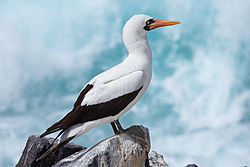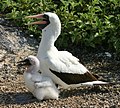Reproduction
The Nazca booby nests near cliffs on bare ground with little to no vegetation. [7] The male chooses and defends a territory, then enters into courtship to attract females. [15]
Like many seabirds, the species has a long lifespan combined with low annual reproduction and long periods of development in the young. Clutch size is one or two eggs, due to the low hatching success, however when 2 eggs are laid and they both hatch, it is common for only one of the chicks to survive. [16] Usually, whichever is the first to hatch is the one that survives. [17]
While many species of birds regulate egg temperature via an incubation patch, a layer of bare skin that allows birds to transmit heat into their eggs, the Suliformes instead use the skin on their webbed feet in addition to heat transferred from the breast. The feet are heavily vascularized, especially during the nesting period. [18] Both the male and the female show parental care. [19] Usually the chick that hatches first is bigger and becomes aggressive towards its sibling, excluding it from feeding and eventually starving it. [16]
The energy investment on the parent's part is very high, so their metabolic rates change during the nesting season. This causes both parents to lose similar amounts of body weight and suffer a decline in their immune system activity. [19] This adjustment does not take place when the parents decide not to nest, a decision that is mostly driven by food availability, which in turn depends on ocean current and climate patterns such as those driven by the El Niño oscillation. [13]
Siblicide has been well studied in this species; the first chick is born around five days before the second and is larger and stronger by the time the second is born. It drags its younger sibling out of the nest. Field experiments in the Galapagos demonstrated that the boobies can manage to feed two chicks without too much difficulty. This raises questions as to the origin of the phenomenon. [20] [21]








